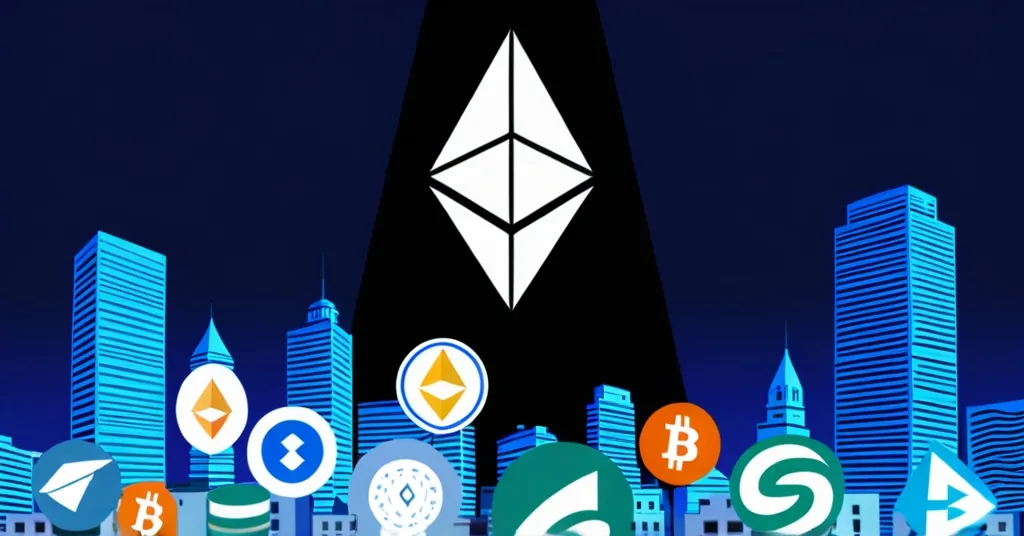Ethereum Leads RWA Tokenization with $4.1B AUM, 54.5% Market Share

Ethereum Dominates Real-World Asset Tokenization with $4.1B in AUM
Ethereum has emerged as the leading platform for real-world asset (RWA) tokenization, securing a commanding 54.5% market share and managing assets worth $4.1 billion. This surge in value is driven by institutional adoption and the involvement of traditional companies, although other blockchains like zkSync Era and Stellar are also making strides.
- Ethereum holds $4.1B in RWA AUM, with 54.5% market share.
- Institutional and traditional company involvement fuels growth.
- Other blockchains like zkSync Era and Stellar are catching up.
Real-world asset tokenization, the process of converting tangible or financial assets into digital tokens on a blockchain, is gaining traction. Ethereum’s robust infrastructure allows for the tokenization of assets such as money market funds and government bonds, marking a significant shift toward integrating traditional finance with blockchain technology.
Over the last month, Ethereum’s RWA value has increased by 10%, and its market share has risen by 3.39%. The number of RWA holders has grown by 3.05%, reaching 62,280, with a total of 163 RWA tokens issued on the platform. This growth isn’t just organic; it’s propelled by major institutional players.
13 of the 20 financial institutions identified as having built crypto-specific infrastructure and applications were issuing RWAs on Ethereum and its L2s.
– Christine Kim, Vice President of Research at Galaxy Digital.
The involvement of traditional financial giants is significant. Over 50 traditional companies, including Deutsche Bank, PayPal, Louis Vuitton, and Adidas, are developing crypto-specific applications on Ethereum and its layer 2 solutions.
More than 50 traditional companies including financial institutions like Deutsche Bank and Paypal and brands like Louis Vuitton and Adidas, were developing crypto-specific applications on Ethereum and its L2s.
– Christine Kim.
Ethereum’s lead in RWA tokenization is clear when compared to other blockchains. While zkSync Era, a layer 2 solution, boasts a $1.95 billion AUM, it’s still nearly four times less than Ethereum’s total. Stellar follows with $405.17 million, and other platforms like Aptos, Polygon, Avalanche, Solana, and Arbitrum trail further behind.
So, what’s behind Ethereum’s preference? It’s a combination of its strong smart contract ecosystem, robust security, powerful network effects, and the scalability offered by layer 2 solutions. The anticipation of a crypto-friendly regulatory environment in the U.S. is also a significant boost.
The value of RWAs issued on Ethereum alone had quadrupled over the past year.
– Christine Kim.
Stablecoins like Tether’s USDT and Circle’s USDC dominate the tokenized asset space on Ethereum, with market shares of 58.37% and 29% respectively. These assets are part of the broader trend of tokenization that’s reshaping asset management and ownership.
While Ethereum leads, other blockchains aren’t standing still. Solana, for instance, is making strategic moves into RWA tokenization with initiatives like the Securitize integration, aiming to offer institutional investors low-cost, high-speed transactions.
Solana was making a strategic push into RWA tokenization with the Securitize integration aiming to provide institutional investors with low-cost, high-speed transactions.
– Nick Ducoff, head of institutional growth at the Solana Foundation.
Despite Ethereum’s dominance, the RWA tokenization space is dynamic. As more traditional institutions and brands embrace blockchain technology, the landscape will continue to evolve. But for now, Ethereum’s lead is undeniable, supported by its technology, institutional backing, and growing ecosystem.
However, it’s not all sunshine and rainbows. Ethereum’s dominance raises questions about centralization within the decentralized world. Can other blockchains like Solana, with its high-speed transactions, or Stellar, with its focus on cross-border payments, challenge Ethereum’s throne? And let’s not forget the potential regulatory hurdles and security concerns that could slow down this tokenization revolution.
As a champion of decentralization and disruption, it’s worth considering whether Ethereum’s focus on RWAs might detract from its broader mission of fostering a decentralized finance (DeFi) ecosystem. While Bitcoin maximalists might argue that Bitcoin’s simplicity and security make it the true king of cryptocurrencies, Ethereum’s versatility and adoption by traditional finance undeniably carve out a unique space in the crypto landscape.
Key Takeaways and Questions
- What is the current market share of Ethereum in RWA tokenization?
Ethereum holds a 54.5% market share in RWA tokenization.
- How has the value of RWAs on Ethereum changed over the past year?
The value of RWAs on Ethereum has quadrupled over the past year.
- Which types of assets are being tokenized on Ethereum?
Assets being tokenized on Ethereum include money market funds, government bonds, and commodities.
- Why is Ethereum favored by traditional financial institutions for RWA issuance?
Ethereum is favored due to its strong smart contract ecosystem, security, network effects, and the scalability provided by layer 2 solutions.
- What role do layer 2 solutions like zkSync Era play in RWA tokenization?
Layer 2 solutions like zkSync Era enhance Ethereum’s scalability, offering lower fees and faster transactions while maintaining security through the base layer.
- How are other blockchains performing in RWA tokenization compared to Ethereum?
Other blockchains like zkSync Era, Stellar, Aptos, Polygon, Avalanche, Solana, and Arbitrum have significantly lower RWA values compared to Ethereum, indicating Ethereum’s dominance in this space.



